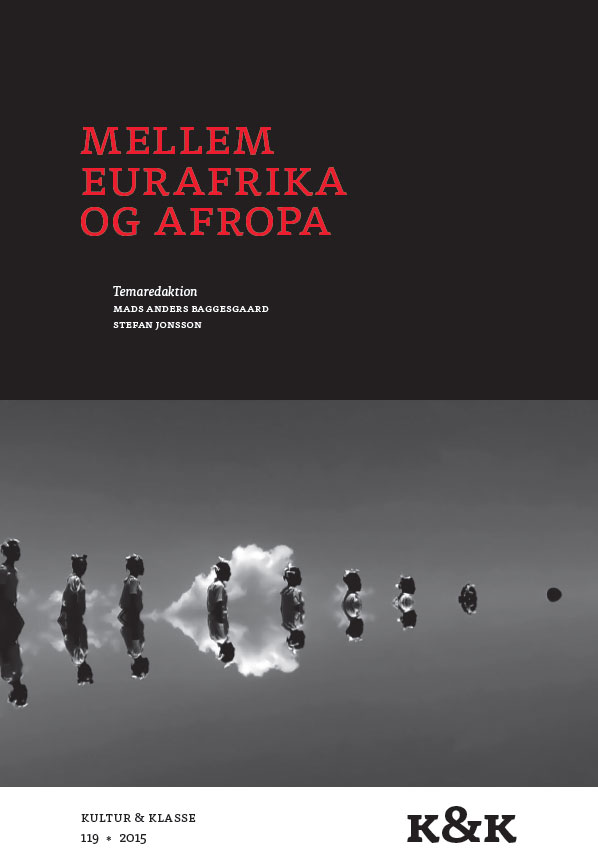Virunga National Park - Steder og rettigheder for gorillaer og mennesker i Afrika
DOI:
https://doi.org/10.7146/kok.v43i119.22243Nøgleord:
geocriticism, ecocriticism, human rights, animal rights, gorilla narratives, Congo Reform Movement, Dian Fossey, World HeritageResumé
The article outlines some of the historical traces for the eco-crisis that presently threatens the first and most outstanding national park in Africa, homeland of the mountain gorilla. After a short description of the site, the article presents the Congo Reform Movement’s campaign against the bloody suppression in the Congo Free State around 1900, often referred to as the Red Rubber-regime. The Congo Reform Movements “Atrocity Meetings” are considered to be the first human rights campaign, because they established the rhetorical models that we find today in Amnesty International, Human Rights Watch and Global Witness. The article argues that we can detect similar and highly problematic structures in the animal rights campaigns which took on a global scale in the 1970s – initiated among others by Dian Fossey and her famous and infamous fight for the protection of mountain gorillas in the Virunga mountains. Both human rights campaigns and animal rights campaigns share a responsibility, I argue, for the eco-crisis at Virunga. Finally I present the documentary Virunga from 2014 as a model and as a rhetorical alternative.Referencer
Andersen, Frits. Det mørke kontinent. Afrikabilleder i europæiske fortællinger om Congo. Gylling: Aarhus Universitetsforlag, 2010.
Battani, Marshall. ”Atrocity Aesthetics: Beyond Bodies and Compassion”. Afterimage (2011). [forlag mangler]
Conniff, Richard. ”Discovering Gorilla”. Evolutionary Antropology 18, 2 (2009).
”Du Chaillu’s Adventures in Equatorial Africa”. The Edinburgh Review 1. juli 1861.
Du Chaillu, Paul. The Country of the Dwarfs. London: Harper & Brothers, 1901.
Fossey, Dian. Gorillas in the Mist. London: Phoenix, 1981.
Geetleman, Jeffrey. ”Oil Dispute Takes a Page From Congo’s Bloody Past”. New York Times 15. november 2014.
Gehrmann, Susanne. Congo-Greuel. Zur literarischen Konfiguration eines kolonialkritischen Diskurses (1890-1910). Hildesheim: Georg Olms Verlag, 2003.
Giles-Vernick, Tamara og Stephanie Rupp. ”Visions of Apes, Reflections on Change: Telling Tales of Great Apes in Equatorial Africa”. African Studies Review 49, 1 (2006).
Grant, Kevin. A Civilised Savagery. Britain and the New Slaveries in Africa, 1884-1926. London: Routledge, 2005.
Grant, Kevin. ”Christian critics of empire: Missionaries, lantern lectures, and the Congo reform campaign in Britain”. Journal of Imperial and Commonwealth History 29, 2 (2008).
Haraway, Donna. Primate Visions: Gender, Race, and Nature in the World of Modern Science. New York: Routledge, 1989.
Herbert, Herbert. ”Renzo Martens by Martin Herbert”. ArtReview (2009).
Hodgson, Amanda. ”Defining the Species: apes, savages and humans on scientific and literary writing of the 1860s”. Journal of Victorian Culture (2001).
Jenkins, Mark. ”Who murdered the Virunga Gorillas?”. National Geographic (2008).
Lifshey, Adam. ”An Américain in Africa. The Transatlantic Creations of Paul Belloni du Chaillu”. Journal of Transnational American Studies 3, 1 (2011).
Massey, Doreen. ”En global fornemmelse for sted”. Sted. Red. Anne-Marie Mai. Gylling: Aarhus Universitetsforlag, 2010.
Miller, John. ”Meat, Cannibalism and Humanity in Paul du Chaillu’s Explorations and Adventures in Equatorial Africa”. Gothic Studies 16, 1 (2014).
Morel, Edmund D. Red Rubber. The Story of the Rubber Slave Trade Flourishing on the Congo in the Year of Grace 1906. London: T. Fisher Unwin, 1906.
Mowat, Farley. Dian Fossey og bjerggorillaerne i Afrika. København: Samleren, 1988.
Peffer, John. ”Snap of the Whip/Crossroads of Shame. Flogging, Photography, and the Representation of Atrocity in the Congo Reform Campaign”. Visual Anthopology Review 24 (2008).
Ringer, Greg. ”Gorilla tourism”. Alternatives Journal 28, 4 (2002).
Salak, Kira. ”Places of Darkness”. National Geographic Adventure (2004).
Salopek, Paul F. ”The Mountain Gorillas of Africa. A Fragile Home Threatened by War”. National Geographic 188, 4 (1995).
Sliwinski, Sharon. ”The Childhood of Human Rights: The Kodak on the Congo”. Journal of Visual Culture (2006).
Thompson, T. Jack. ”Light on the dark continent: The photography of Alice Seely Harris and the Congo atrocities of the early twentieth century”. International Bulletin of Missionary Research (2002).
Twomey, Christina. ”Framing Atrocity: Photography and Humanitarianism”. History of Photography 36, 3 (2012).
Whitlock, Gillian. ”Remediating Gorilla Girl: Rape Warfare and the Limits of Humanitarian Storytelling”. Biography 33, 3 (2010).
”With Mr. Gorilla’s Compliments”. Temple Bar 1. november 1861.
Downloads
Publiceret
Citation/Eksport
Nummer
Sektion
Licens
Tidsskriftet følger dansk ophavsret.





